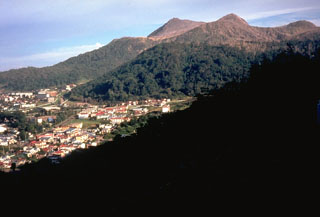Report on Toya (Japan) — October 1977
Natural Science Event Bulletin, vol. 2, no. 10 (October 1977)
Managing Editor: David Squires.
Toya (Japan) Continued cryptodome uplift and weak emission of steam clouds
Please cite this report as:
Global Volcanism Program, 1977. Report on Toya (Japan) (Squires, D., ed.). Natural Science Event Bulletin, 2:10. Smithsonian Institution. https://doi.org/10.5479/si.GVP.NSEB197710-285030
Toya
Japan
42.544°N, 140.839°E; summit elev. 733 m
All times are local (unless otherwise noted)
Surface activity during September was confined to continued cryptodome uplift and weak emission of steam clouds, which rose a maximum of 600 m from summit vents [produced by the August eruption]. Daily recorded seismic events, including many felt shocks, declined irregularly through September, but remained high at the end of the month (figure 6).
 |
Figure 6. Graph of monthly volcanic earthquakes at Usu, July 1966-July 1977 [showing a gradual increase in seismicity]. The monthly mean is 9. Courtesy of JMA. |
Geological Summary. Usuzan, one of Hokkaido's most well-known volcanoes, is a small stratovolcano located astride the southern topographic rim of the 110,000-year-old Toya caldera. The center of the 10-km-wide, lake-filled caldera contains Nakajima, a group of forested Pleistocene andesitic lava domes. The summit of the basaltic-to-andesitic edifice of Usu is cut by a somma formed about 20-30,000 years ago when collapse of the volcano produced a debris avalanche that reached the sea. Dacitic domes erupted along two NW-SE-trending lines fill and flank the summit caldera. Three of these domes, O-Usu, Ko-Usu and Showashinzan, along with seven crypto-domes, were erupted during historical time. The 1663 eruption of Usu was one of the largest in Hokkaido during historical time. The war-time growth of Showashinzan from 1943-45 was painstakingly documented by the local postmaster, who created the first detailed record of growth of a lava dome.
Information Contacts: JMA, Tokyo.

